GDP (US$ Billion)
53.30 (2018)
World Ranking 85/193
GDP Per Capita (US$)
18,994 (2018)
World Ranking 46/192
Economic Structure
(in terms of GDP composition, 2019)
External Trade (% of GDP)
150.6 (2019)
Currency (Period Average)
Euro
0.89per US$ (2019)
Political System
Unitary multiparty republic
Sources: CIA World Factbook, Encyclopædia Britannica, IMF, Pew Research Center, United Nations, World Bank
Overview
Lithuania is one of the European Union (EU)'s fastest growing economies, partly owing to the improved economic situation in Lithuania's major export partners. The Lithuanian economy is oriented around manufacturing and service industries (particularly shared services centres). Following a peak in 2017, the economy will sustain robust growth in upcoming quarters, driven by strong domestic demand and a low household debt burden. In the medium term, growing constraints such as rapidly rising labour costs will see growth even out to more sustainable levels. The commercial environment is generally friendly to foreign companies, and most EU directives are implemented in the Lithuanian legislative system. Lithuania has a developed private-enterprise economy that is actively growing thanks to an advantageous geographic location in Eastern Europe, highly developed transport connections, a modern seaport and IT network, and a highly educated labour force.
Sources: World Bank, Fitch Solutions
Major Economic/Political Events and Upcoming Elections
September 2017
Lithuania's government lost its majority in parliament after its junior coalition partner quit.
May 2019
Lithuania held elections for the country's president on May 12, 2019. A second round for the presidential elections was held because no candidate achieved the requisite 50% of the vote.
June 2019
Former banker Gitanas Nausėda was elected president of the country in the run-off election, with 66.5% of the vote.
The Three Seas Initiative Investment Fund was announced, which would focus on transport, energy and digital infrastructure projects in the Three Seas region. Lithuania was one of the 12 EU member states involved, all located between the Adriatic, the Baltic and the Black seas.
July 2019
Prime Minister Saulius Skvernelis won a confidence vote in parliament, as required following the presidential election.
The government started analysing the effects of levying a tax in 2020 on polluting vehicles. The measure was to encourage the population to transition to more environmentally friendly vehicles.
November 2019
Eurostat revealed that the lowest male life expectancy in the EU was in a region of central and western Lithuania, where men lived on average until the age of 69.7.
December 2019
Lithuania ranked highest among the countries of emerging Europe (and eighth globally out of 57) in the 2020 edition of the Climate Change Performance Index.
February 2020
Lithuania, Latvia and Estonia were due to synchronise their power grid with the rest of Europe in the next five years and withdraw from the transmission framework shared with Russia and Belarus.
President Nausėda welcomed a Japanese delegation to Vilnius, and took the opportunity to refer to the improving economic cooperation between the two countries and untapped synergies in energy, transport and logistics, the food industry, life sciences and finance.
October 2020
The country will hold parliamentary elections on October 11 and 25, 2020.
July 2021
Foreigners will be able to obtain e-residency, register companies, use banking services and pax taxes all using online services only without moving to Lithuania. The legislation was passed by parliament in July 2019.
Sources: BBC Country Profile – Timeline, Baltic Times, Emerging Europe, Fitch Solutions
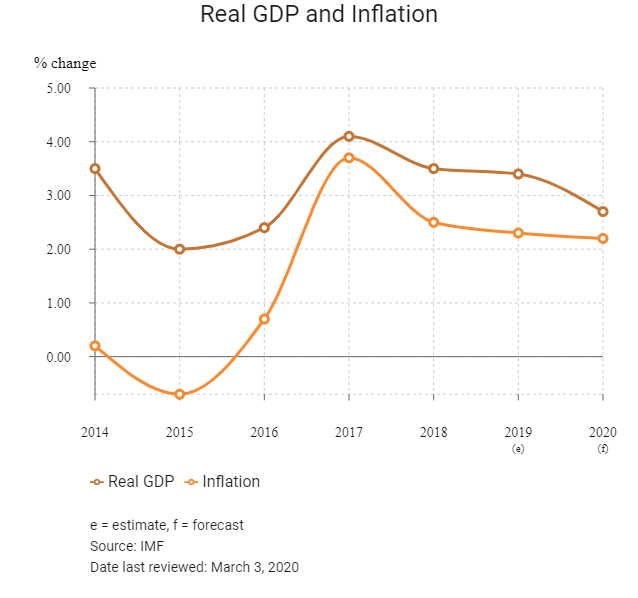
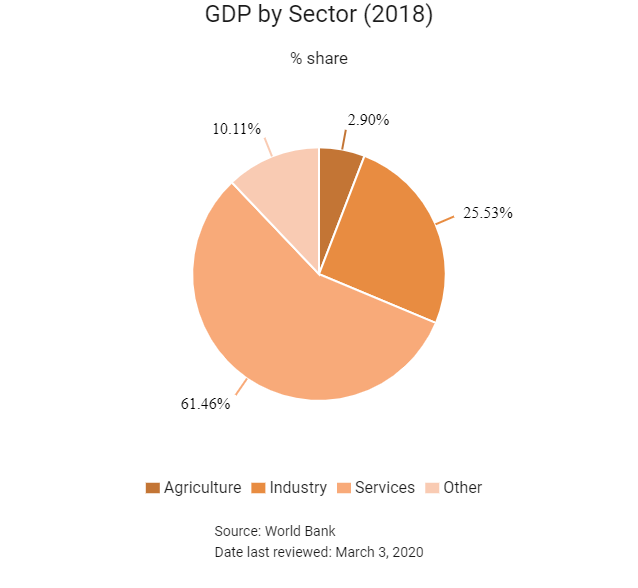

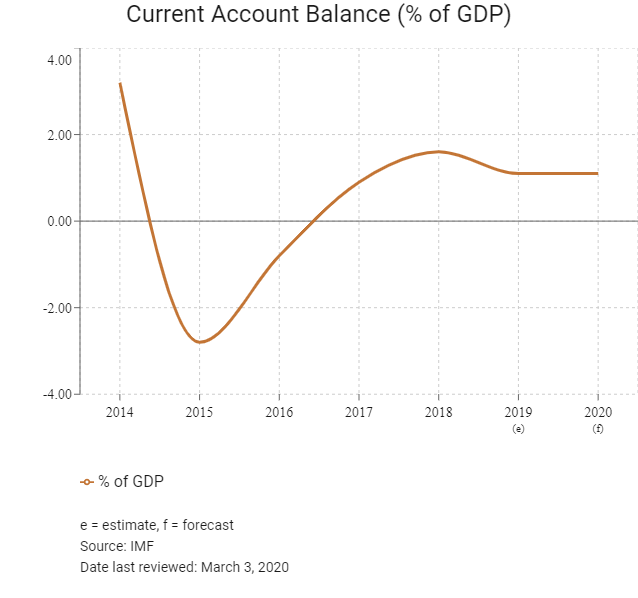

Merchandise Trade
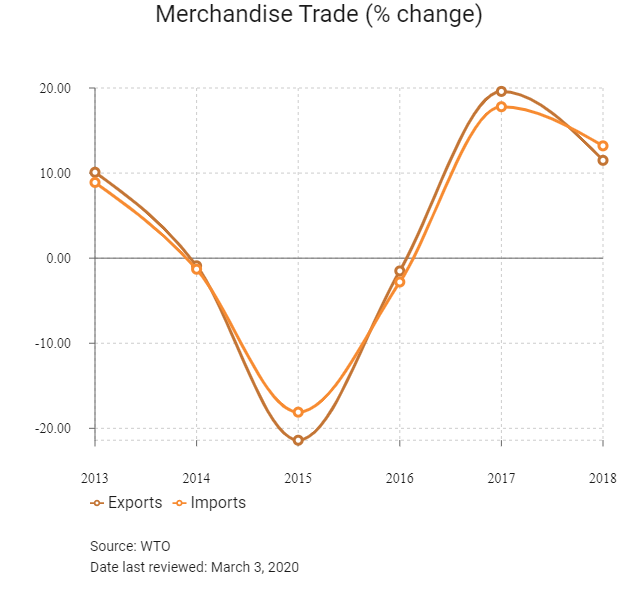
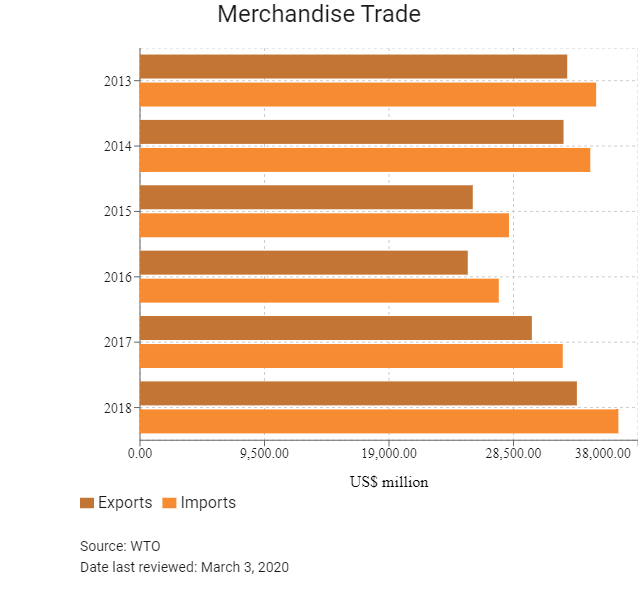
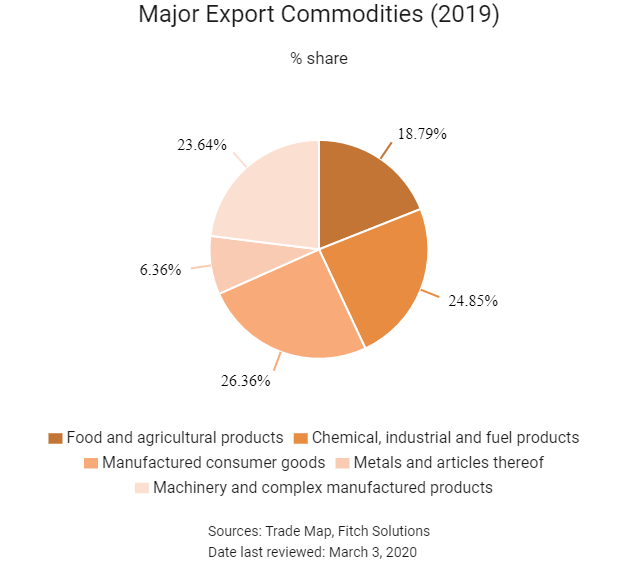
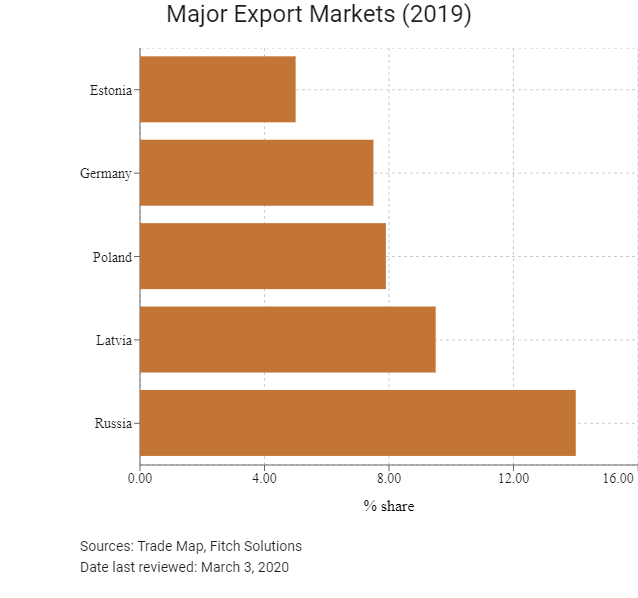
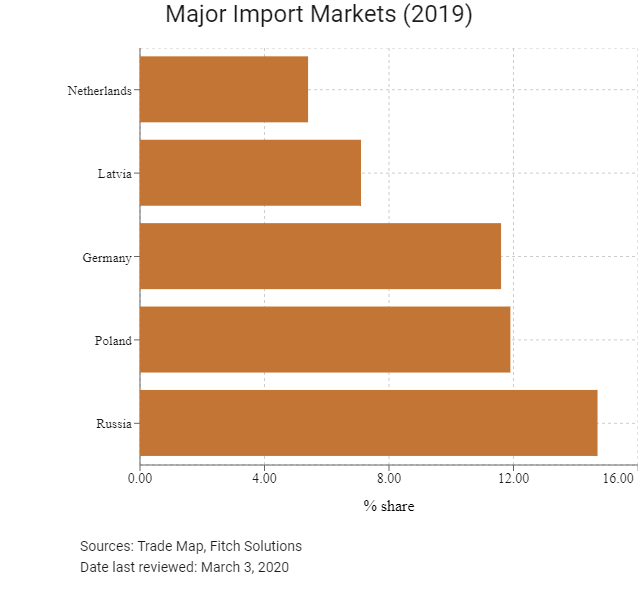
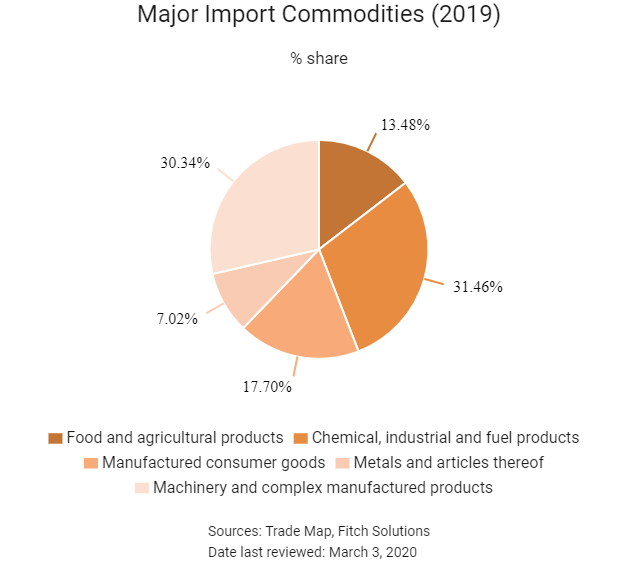
Trade in Services
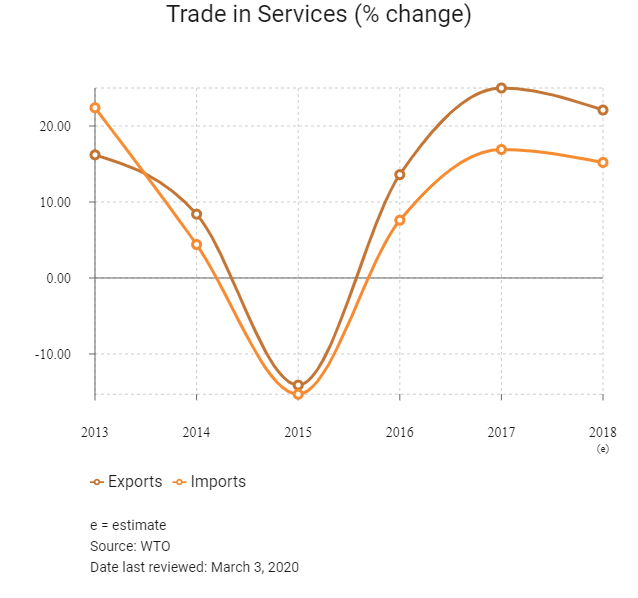

- Lithuania joined the World Trade Organization (WTO) on May 31, 2001. On May 1, 2004, it joined the EU.
- As a member state of the EU, Lithuania incorporates EU regulatory norms. As a eurozone member, Lithuania adopted the euro as its legal tender from January 1, 2015.
- As a member state of the EU, Lithuana has a common set of tariffs and customs levied on various imports and exports. The trade policy is largely identical to that of the wider regional bloc. The EU updated its trade policy (and, by extension, its import tariffs, customs, duties and procedures) in 2017 and 2018. Once goods are cleared by customs authorities upon entry into any EU member state, these imported goods can move freely among EU member states without any additional customs procedures.
- The EU has an overall simple tariff of 5.1%. The duties for non-European countries are also relatively low, especially for manufactured goods (4.2% on average). However, textile, clothing items (high duties and quota system) and food-processing industry sectors (average duties of 17.3% and numerous tariff quotas) still see protective measures. Most of Lithuania's major trade partners are within the EU, hence risks are less pronounced.
- In 2018 the EU modernised its trade defence instruments, with a view to shielding EU producers from damage caused by unfair competition. Anti-dumping and anti-subsidy regulations have been amended to better respond to unfair trade practices and to furnish Europe's trade defence instruments with more transparency, quicker procedures and more-effective enforcement. In exceptional cases, such as in the presence of distortions in the cost of raw materials, the EU will be able to impose higher duties through the limited suspension of the lesser-duty rule.
- Nine types of goods imported into the EU are subject to licensing. These goods are (broadly) textiles, various agricultural products, iron and steel products, ozone-depleting substances, rough diamonds, waste shipment, harvested timber, endangered species and drug precursors. Currently, no quotas are imposed on textiles and clothing exports or non-textile product exports from Hong Kong and Mainland China.
- The European Commission (EC) has introduced an import licensing regime for certain iron, steel and aluminium products exceeding 2.5 tonnes. The regulation will be active until May 15, 2020.
- In order to protect domestic industries, a number of products from Mainland China are subject to the EU's anti-dumping duties, including bicycles, bicycle parts, ceramic tiles, ceramic tableware and kitchenware, fasteners, ironing boards and solar glass, which are of interest to Hong Kong exporters. For example, in November 2016 the EC imposed a provisional anti-dumping duty on imports of some primary and semi-processed metals from Mainland China. The rate of duty is between 43.5% and 81.1% of the net, free-at-union-frontier price before duty, depending on the company. By way of comparison, the rate of duty for similar goods from Belarus is 12.5% of the net, free-at-union-frontier price before duty. As of February 2020, the EU did not apply any anti-dumping measures on imports originating from Hong Kong. In October 2019, following an appeal heard by the General Court of the EU, a judgement was issued that annuls the anti-dumping duties imposed on imports of solar glass from Mainland China.
- In March 2016, the EC imposed a definitive countervailing duty (8.7% or 9%) on imports consisting largely of textiles products originating in India.
- A multitude of issues persists with regard to the respect for intellectual property rights in Mainland China, which means many Lithuanian manufacturing and retail businesses face additional risks when importing finished or intermediate goods from this trading partner.
- To combat the spread of the Asian long-horned beetle, in July 1999 the EU introduced emergency controls on wooden packaging material originating in Mainland China. Wood covered by the measures must be stripped of its bark and free of insect bore holes greater than 3mm across or have been kiln-dried to below 20% moisture content.
- For health reasons, the EU has adopted a directive on the control of the use of nickel in objects intended to be in contact with the skin, such as watches and jewellery. The EU has also adopted a directive to ban the use of some phthalates in certain PVC toys and childcare articles on a permanent basis, which came into effect from January 16, 2007. In addition, the EU has adopted a directive to prohibit the trading of clothing, footwear and other textile and leather articles that contain azo-dyes, from which aromatic amines may be derived.
- In the second quarter of 2015, the EC issued regulations on trade restrictions with Turkey regarding cattle, beef, watermelons and prepared tomatoes to protect domestic agriculture and regional farming businesses.
- On January 1, 2017, the EU imposed additional import duties on certain fruit and vegetables if the quantity of the goods exceeded the trigger volume level within the specified application period. On November 15, 2017, the EC allocated a total value of EUR62.0 million (USD74.4 million) for funding promotional campaigns of EU agricultural products implemented in the internal market for 2018. The budget consists of various promotional topics of EU goods in the internal market with an additional focus on the promotion of fruit, vegetables and sheep or goat meat.
- The EU has adopted a number of directives for environmental protection, which may have an impact on the sale of a wide range of consumer goods and consumer electronics. Notable examples include the directive on Waste Electrical and Electronic Equipment (WEEE) implemented in August 2005, and the directive on Restriction of Hazardous Substances (RoHS) implemented in July 2006. A recast WEEE directive entered into force in August 2012 as a result of which member states must adhere to higher collection/recycling targets (a 45% collection rate as of 2016 and 65% from 2019). The directive is also wider in scope, covering all electric and electronic equipment, while establishing producer responsibility as a means of encouraging greener product designs. The recast RoHS directive was published on July 1, 2011, and entered into force on January 2, 2013. The new directive continues to prohibit electrical and electronic equipment that contains the same six dangerous substances as listed in the original RoHS directive. Since July 22, 2019, the new directive has widened the scope of the previous directive by including any electrical and electronic equipment that will have fallen out of the old RoHS directive's scope, with only limited exceptions. Following those recast directives, the EU's new framework directive for setting eco-design requirements for energy-related products (ErP) is now in place. The ErP Directive is no longer limited to electrical and electronic equipment (as it was under its predecessor, the energy-using product or EuP Directive), but potentially covers any product that is related to the use of energy, including shower heads and other bathroom fittings, as well as insulation and construction materials.
- REACH, an EU regulation which stands for Registration, Evaluation, Authorisation and Restriction of Chemicals, entered into force in June 2007. It requires EU manufacturers and importers of chemical substances to gather comprehensive information on the properties of these substances produced or imported in volumes of one tonne or more per year, and to register such substances prior to manufacturing in or importing into the EU.
- The EU has the largest web of preferential trade agreements in the world, being party to some 70 free trade agreements (FTAs) spanning five continents, and, consequently, access to other markets of the countries concerned is currently mediated through those agreements. The EU's scheme on generalised system of preferences (GSP) entered into effect on January 1, 2014. Under the scheme, tariff preferences have been removed for imports into the EU from countries where per capita income has exceeded US$4,000 for four years in a row. As a result, the number of countries that enjoy preferential access to EU markets was reduced from 176 to less than 80. While Mainland China remains a beneficiary, many of its exports – such as toys, electrical equipment, footwear, textiles, wooden articles and watches and clocks – have already been graduated from the preferential treatment. Regarding Hong Kong, the territory has been fully excluded from the EU's GSP scheme since May 1, 1998.
- With talks between the EU and the United States on a Transatlantic Trade and Investment Partnership having been suspended at the end of 2016, in April 2019 the EU and United States' chemical industries proposed an enhanced aligned approach that could serve as a global blueprint for regulatory cooperation to reduce barriers and increase trade in the chemicals sector.
Sources: WTO – Trade Policy Review, European Commission, Fitch Solutions
Trade Updates
As a member of the EU, Lithuania is party to the same trade agreements as its 26 peer states. The region negotiates and enters into trade agreements as a collective due to the single-market nature of the union. In total, the EU is party to some 70 FTAs. It is expected that membership of the eurozone will lead to further convergence towards EU economic policymaking norms.
↵
Multinational Trade Agreements
Active
- The EU Common Market: The transfer of capital, goods, services and labour between member nations enjoy free movement. The common market extends to the 27 member nations of the EU, namely: Austria, Belgium, Bulgaria, Croatia, Cyprus, the Czech Republic, Denmark, Estonia, Finland, France, Germany, Greece, Hungary, Ireland, Italy, Latvia, Lithuania, Luxembourg, Malta, the Netherlands, Poland, Portugal, Romania, Slovakia, Slovenia, Spain and Sweden. Because Lithuania's main trade partners are in the EU, accounting for more than half of exports and nearly two-thirds of imports, the absence of customs charges with member countries greatly enhances its trade volumes.
- European Economic Area (EEA)-European Free Trade Association: This economic integration agreement entered into force on January 1, 1994. The agreement unites the EU member states, the three non-EU member states of the EEA (Iceland, Liechtenstein, Norway) that are also members of EFTA and Switzerland, which is a member of EFTA but not of the EU or EEA, into an internal market governed by the same basic rules. These rules aim to enable goods, services, capital and persons to move freely about the signatory countries in an open and competitive environment, a concept referred to as the four freedoms. Although the agreement enhances trade flows between the EFTA countries and the EU, only Switzerland is a fairly major trading partner.
- EU-Japan Economic Partnership Agreement (EPA): The agreement entered into force on February 1, 2019, creating the largest open trade zone in the world. The EU and Japan trade deal promises to eliminate 99% of tariffs that cost businesses in the EU and Japan nearly EUR1 billion annually. According to the EC, the EU–Japan EPA creates a trade zone covering 600 million people and nearly one-third of global GDP. The result of four years of negotiation, the EPA was finalised in late-2017 and was signed in July 2018. The total trade volume of goods and services between the EU and Japan is an estimated EUR86.0 billion. The key parts of the agreement will cut duties on a wide range of agricultural products, and it seeks to open up services markets, particularly financial services, e-commerce, telecommunications and transport. Japan is the EU's second-largest trading partner in Asia after Mainland China. EU exports to Japan are dominated by motor vehicles, machinery, pharmaceuticals, optical and medical instruments and electrical machinery.
- EU-Turkey Customs Union: The EU and Turkey are linked by a Customs Union agreement, which came into force on December 31, 1995. Turkey has been a candidate country to join the EU since 1999, and is a member of the Euro-Mediterranean partnership. The Customs Union with the EU provides tariff-free access to the European market for Turkey, benefitting both exporters and importers. Turkey is the EU's fourth-largest export market and fifth-largest provider of imports. The EU is by far Turkey's number one import and export partner. Turkey's exports to the EU are mostly machinery and transport equipment, followed by manufactured goods. At present, the Customs Union agreement covers all industrial goods, but does not address agriculture (except processed agricultural products), services or public procurement. Bilateral trade concessions apply to agricultural as well as coal and steel products. In December 2016, the EC proposed the modernisation of the Customs Union and to further extend the bilateral trade relations to other areas, such as services, public procurement and sustainable development.
- EU-Canada Comprehensive Economic and Trade Agreement (CETA): CETA is expected to strengthen trade ties between the two regions, having provisionally entered into force on September 21, 2017. Some 98% of trade between Canada and the EU is duty-free under CETA. The agreement is expected to boost trade between partners by more than 20%. CETA also opens up government procurement. Canadian companies will be able to bid on opportunities at all levels of the EU government procurement market and vice versa. CETA means that Canadian provinces, territories and municipalities are opening their procurement to foreign entities for the first time, albeit with some limitations regarding energy utilities and public transport.
- EU-Southern African Development Community (SADC) Economic Partnership Agreement (EPA): An agreement between the EU and and a group of SADC countries (Botswana, Eswatini, Lesotho, Mozambique, Namibia and South Africa) was signed on June 10, 2016, with Angola having an option to join the agreement in the future. The agreement provisionally entered into force for most countries on October 10, 2016, but only became fully operational after Mozambique began applying the EPA in February 2018. Nine of the remaining members of SADC not included in the deal (Comoros, the Democratic Republic of the Congo, Madagascar, Malawi, Mauritius, the Seychelles, Tanzania, Zambia and Zimbabwe) have or are seeking economic partnership agreements with the EU as part of other regional trading blocs – such as with East, Central or Southern African communities.
Ratification Pending
- EU-Central America Association Agreement (Guatemala, El Salvador, Honduras, Nicaragua, Costa Rica, Panama): An agreement between the parties was reached in 2012 and is awaiting ratification (31 of the 33 parties have ratified the agreement as of February 2020). The agreement has been provisionally applied since 2013.
- EU-Mercosur Trade Agreement: An agreement between the parties was reached on June 28, 2019. The agreement means the EU is the first major partner to make a trade pact with the Mercosur bloc, which comprises Argentina, Brazil, Paraguay and Uruguay. The agreement will cover a population of 780 million and gives EU-based companies easier entry into a market with an enormous economic potential, saving them EUR4 billion in duties annually. Currently, EU-Mercosur trade in goods amounts to approximately EUR87 billion, but this is down from EUR100 billion just a few years ago, with Mainland China having outpaced the EU as Mercosur's first trading partner. The EU is the biggest foreign investor in Mercosur, with stock of EUR381 billion, while Mercosur's investment stock in the EU is worth EUR52 billion. The agreement contains specific commitments on labour rights and environmental protection, including the implementation of the Paris climate agreement and related enforcement rules. The EU will not fully open its market for imports of agri-food products, although beef, poultry and honey imports from the Mercosur countries will be permitted to increase over a five-year phasing in period.
- EU-Vietnam FTA and Investment Protection Agreement (IPA): On June 30, 2019, the EU and Vietnam signed the final texts for the EU-Vietnam FTA and the EU-Vietnam IPA. As of February 2020, the FTA and IPA await approval by the European Parliament and national parliaments before being concluded. Once in force, the agreements will provide opportunities to increase trade and support jobs and growth on both sides by eliminating 99% of all tariffs, reducing regulatory barriers and overlapping 'red tape', ensuring protection of geographical indications, opening up services and public procurement markets and establishing the means to ensure the agreed rules are enforceable.
- EU-Singapore Free Trade Agreement (EUSFTA): On February 13, 2019, the European Parliament passed the agreement, signed earlier on October 19, 2018, which would see the creation of the EUSFTA. The agreement provisionally entered into force on November 21, 2019, but before the investment protection agreement is implemented, all the states involved need to ratify the agreement through their individual legislatures.
Under Negotiation
- EU-Australia FTA: The EU, Australia's second-largest trade partner, has launched negotiations for a comprehensive trade agreement with Australia. Bilateral trade in goods between the two partners has risen steadily in recent years, reaching almost EUR66 billion in 2018, and bilateral trade in services added an additional EUR32 billion. The negotiations aim to remove trade barriers, streamline standards and put European companies exporting to or doing business in Australia on equal footing with those from countries that have signed up to the Comprehensive and Progressive Agreement for Trans-Pacific Partnership (CPTPP) or other trade agreements with Australia. The Council of the EU authorised the opening of negotiations for a trade agreement between the EU and Australia on May 22, 2018, and on June 18, 2018 negotiations were formally launched. The fifth negotiation took place in October 2019.
- EU-United States (Transatlantic Trade and Investment Partnership): This agreement was expected to increase trade and services, but it is unlikely to pass under the Trump administration in the United States against the backdrop of rising global trade tensions.
- EU-Indonesia FTA: Negotiations were launched in July 2016 and in December 2019 the ninth round took place. The objective of the FTA is to facilitate trade and investments and address various issues, such as tariffs, non-tariff barriers to trade, the production of palm oil, trade in services and investment, trade aspects of public procurement, competition rules and intellectual property rights, as well as sustainable development.
Sources: WTO Regional Trade Agreements database, Australia Department of Foreign Affairs and Trade, government websites, Fitch Solutions
Foreign Direct Investment
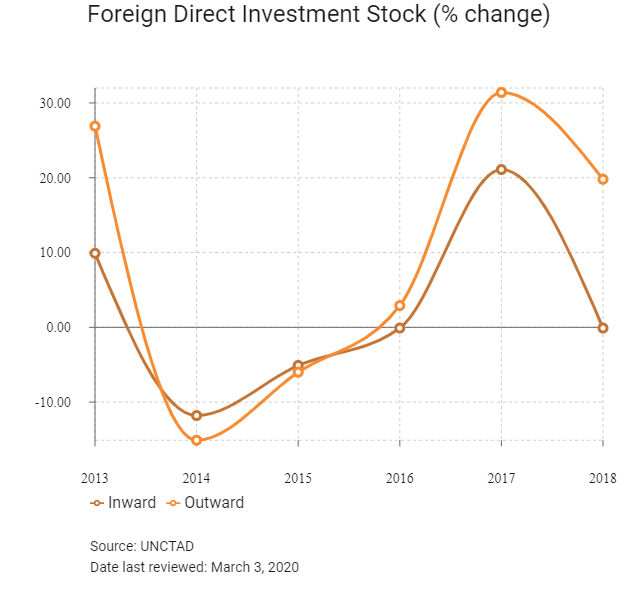
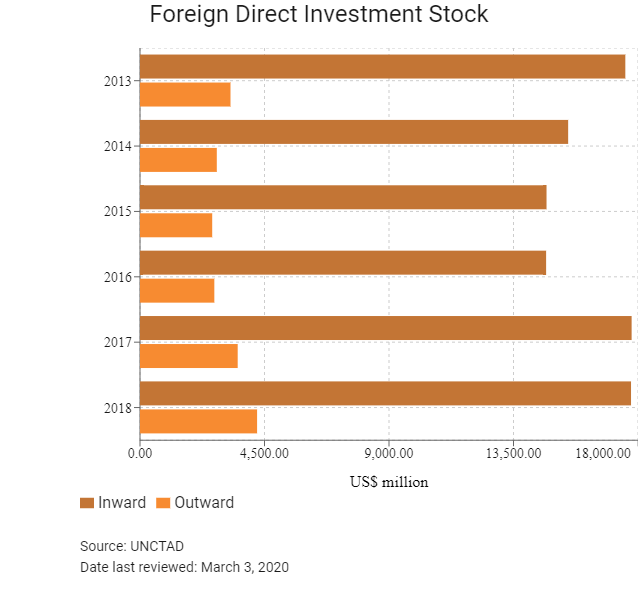
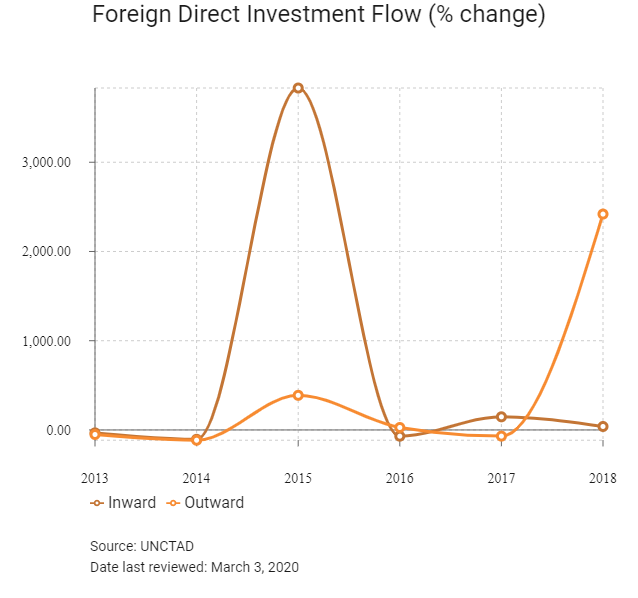
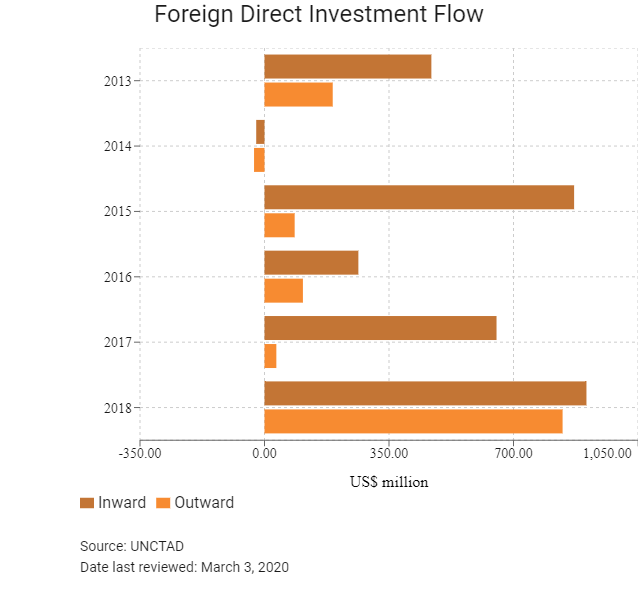
Foreign Direct Investment Policy
- Invest Lithuania is the government's principal institution dedicated to attracting foreign investment and promoting business development. It serves as a one-stop-shop to provide information on business costs, labour, tax and legal settings and other business areas; facilitate the set up and launch of a company; provide help in accessing government financial support; and advocate on behalf of investors for more business-friendly laws. In addition to its offices in Vilnius and major Lithuanian cities, InvestLithuania has representative offices in Belgium, Kazakhstan and the United States (Chicago).
- The Lithuanian economy is oriented towards manufacturing and service industries, including food, the petroleum and chemical industry, information technology, financial services and service centres, transportation, construction, biotechnologies, research and development, and tourism.
- The commercial environment is generally friendly to foreign companies, and most EU directives are implemented in the Lithuanian legislative system. Lithuania's laws assure equal protection for both foreign and domestic investors. No special permit is required from government authorities to invest foreign capital in Lithuania. State institutions have no right to interfere with the legal possession of foreign investors' property. In the event of justified expropriation, investors are entitled to compensation equivalent to the market value of the property expropriated.
- The Law on Investment establishes no limits on foreign ownership or control. Foreign investors have free access to all sectors of the economy, except in sectors related to security and defence.
- Land acquisition (except for agricultural land and forestry) is restricted to companies or individuals who are established or residing in the EU or in countries that are the members of the Organisation for Economic Co-operation and Development (OECD), the North Atlantic Treaty Organization (NATO) or the EEA.
- Local and foreign businesses in Lithuania can apply for support from the EU Structural Funds. Between 2014 and 2020, Lithuania is expected to receive EUR6.8 billion in structural assistance assigned to the EU Cohesion policy. This will include investment in infrastructure, human capital and public administration. The funds are to be used to upgrade companies and the manufacturing sector, boost exports and create industrial parks.
- As an EU member, Lithuania maintains liberal policies in order to attract investment and export-oriented companies. Creating favourable conditions for foreign direct investment and openness to foreign trade is an essential part of the country's economic strategy.
- Investments in Lithuania by other EU member states are governed by the provisions of the Treaty of Rome and by European Union law. Lithuania has bilateral investment treaties (BITs) with 53 countries or economic blocs around the world: Albania, Argentina, Armenia, Australia, Austria, Azerbaijan, Belarus, BLEU (the Belgium–Luxembourg Economic Union), Bosnia and Herzegovina, Bulgaria, Mainland China, Croatia, Czech Republic, Denmark, Estonia, Finland, France, Georgia, Germany, Greece, Hungary, Iceland, India, Israel, Jordan, Kazakhstan, Kuwait, Kyrgyzstan, Latvia, Moldova, Mongolia, Montenegro, the Netherlands, North Macedonia, Norway, Poland, Portugal, Romania, Russia, Serbia, Slovenia, South Korea, Spain, Sweden, Switzerland, Tajikistan, Turkey, Ukraine, the United Kingdom, the United States, Uzbekistan, Venezuela and Vietnam. BITs between Lithuania and Turkey and between Lithuania and Mauritania have been signed but are not yet in force.
- Lithuania has treaties with investment provisions (TIPs) in force with 56 individual countries and economic blocs worldwide. A further 17 have been signed but are not yet in force.
- Lithuania has concluded double taxation agreements with 55 states, including one with Mainland China that came into force on January 1, 1997. Negotiations were completed on a double taxation agreement with Hong Kong on December 12, 2019.
- Lithuania is a member of the OECD, the WTO and the United Nations Conference on Trade and Development.
Source: WTO – Trade Policy Review, government websites, State Tax Inspectorate, Inland Revenue Department of the Government of Hong Kong, Fitch Solutions
Free Trade Zones and Investment Incentives
|
Free Trade Zone/Incentive Programme |
Main Incentives Available |
|
Lithuania has seven Free Economic Zones (FEZs) located near the cities of Akmene Kaunas, Klaipeda, Siauliai, Kedainiai, Panevezys, and Marijampole. The FEZs host approximately 60 investors. |
Businesses choosing to locate at these zones enjoy: |
|
Investment project incentive |
Businesses are able to reduce their taxable profits by up to 100% of costs incurred relating to certain investments. This deductible applies to a number of categories of fixed assets, namely: |
|
Tax relief for R&D activities |
- Expenses relating to R&D can be treated as a tax deductible for the year in which activity occurred. The R&D activities also need to relate to the company/entity's daily operations. |
|
Grants for the development of new or significantly improved products, services or processes; funding for investment into R&D infrastructure, and activities related to process and organizational innovations; and funding for employee training. |
- For industrial research and human resources training the proportions available are: up to 70% for small companies, up to 60% for medium-sized companies and up to 50% for large companies. - For experimental development the proportions available are: up to 70% for micro enterprises and small companies and up to 60% for medium companies. |
Sources: Invest Lithuania, Fitch Solutions
- Value Added Tax: 21%
- Corporate Income Tax: 15%
Source: Ministry of Finance of the Republic of Lithuania
Important Updates to Taxation Information
- Lithuania is introducing a new tax administration system, known as iMAS, which includes e-services for taxpayers.
- On June 7, 2017, Lithuania signed the Multilateral Convention to Implement Tax Treaty Related Measures to Prevent Base Erosion and Profit Shifting Multilateral Instrument. On December 17, 2019, the Lithuanian parliament adopted legislation to impliment European Union Anti-Tax Avoidance Directives into domestic legislation and these amendments became law on January 1, 2020.
- From January 1, 2020, new amendments entered into force for corporate income tax (CIT), social security contributions and real estate tax (RET).
Business Taxes
| Type of Tax | Tax Rate and Base |
| Corporate Income Tax | 15% is the standard rate. An increased 20% CIT rate applies to the taxable profit of banks exceeding a threshold of EUR 2 million. Small companies and agricultural enterprises can apply for a reduced rate of 0% or 5% if certain conditions are met for new and/or small companies |
| Capital Gains Tax | Subject to the same fiscal treatment as CIT |
| Value Added Tax | The standard rate is 21% but a lower rate of 9% applies to public transport, books, residential heating and accommodation; a rate of 5% applies to periodicals and certain medical items; and a zero rate applies to healthcare services, social services provided by not-for-profit entities, education and training services, insurance and re-insurance, gambling, and the rent or sale of immovable property |
| Withholding Tax | Dividends: 15% for non-residents but 0% is payable if certain conditions are met |
| Social security contributions | On all salaries employers pay a mandatory social insurance contribution of 1.45%–2.71%. On salaries of up to EUR104,278 employees pay 19.5% and on salaries over EUR104,278 employees pay 6.98%. In addition, employers pay a contribution of 0.16% of gross salary to the Guarantee Fund (in case of bankruptcy) and a contribution of 0.16% of salary to the Long-term Unemployment Fund |
| Land Tax | An annual tax rate ranging from 0.01% to 4%, depending on the municipality, of the average market value of the land according to the mass valuation conducted every five years |
| Land Lease Tax | State-owned land that is leased to Lithuanian or foreign companies attracts a land lease tax at a rate established by the municipalities, between a minimum of 0.1% and a maximum of 4% |
| RET | An annual tax rate ranging from 0.5% to 3%, depending on the municipality, levied on the value of real estate used for commercial purposes |
Sources: Ministry of Finance of the Republic of Lithuania, State Tax Inspectorate
Date last reviewed: March 3, 2020
The free CSS cleaner allows you to organize your style sheets.
Visa Requirements
Citizens of the European Economic Area (EEA) – the EU member states, Iceland, Norway, Lichtenstein and Switzerland – do not require a visa to enter, reside and work in Lithuania. Anyone staying more than 90 days and up to a maximum of five years must register residency by completing documentation, including supplying an employment contract, letter from an employer or evidence that you are the owner of an enterprise. Non-EU citizens require a Schengen Visa or a Blue Card to work within the country.
Blue Card
The Blue Card is intended for any stay associated with highly qualified employment. A foreigner holding a Blue Card may reside in the country and work in the job for which the Blue Card was issued, or change that job under the conditions defined. High qualification means a duly completed university education or higher professional education which has lasted for at least three years. Alternatively, a minimum of five years' relevant professional experience relating to the activity for which the work permit is being granted. The Blue Card is issued with a term of validity three months longer than the term for which the employment contract has been concluded, but for a maximum period of three years. The Blue Card can be extended. One of the conditions for issuing the Blue Card is a wage criterion – the employment contract must stipulate a gross monthly or yearly wage that is at least 1.5 times more than the gross average annual wage.
Localisation Policies
Employers should register any vacancies with the Ministry of Social Security and Labour. The Employment Service maintains a shortage occupations list by type of economic activity. If a foreigner is exempt from an obligation to have a work permit the employer must notify the Employment Service. Employers must determine whether employing a foreign worker meets the needs of the Lithuanian labour market and should obtain a permit before the arrival of the foreign national.
Visa Requirements
Lithuania is one of 26 countries in the Schengen Area, which means that there is one common visa and no border controls for all nationals of the EU, the EEA or a third country national holding a residence permit of a Schengen state. Lithuania signed the Schengen agreement on April 16, 2003, and started its implementation on December 21, 2007. Other than EU passport holders, citizens of Hong Kong and Macao are among those who do not require a visa for a short-term visit to Lithuania, but all non-EU/EEA/Swiss nationals who wish to stay for longer than 90 days will need to apply for a long-term visa or residence permit. For citizens of Hong Kong and Macao, repeated entry into Schengen countries including Lithuania is possible after a 90-day interval subsequent to leaving the Schengen area. Those entering Lithuania should have a valid medical insurance policy providing no less than EUR30,000 of coverage, proof of means of subsistence ad place of residence (and means to pay for accommodation).
Sources: Migration Department, Fitch Solutions
Sovereign Credit Ratings
|
Rating (Outlook) |
Rating Date |
|
|
Moody's |
A3 (Positive) |
23/08/2019 |
|
Standard & Poor's |
A+ (Stable) |
21/02/2020 |
|
Fitch Ratings |
A (Stable) |
31/01/2020 |
Sources: Moody's, Standard & Poor's, Fitch Ratings
Competitiveness and Efficiency Indicators
|
World Ranking |
|||
|
2018 |
2019 |
2020 |
|
|
Ease of Doing Business Index |
16/190 |
14/190 |
11/190 |
|
Ease of Paying Taxes Index |
18/190 |
18/190 |
18/190 |
|
Logistics Performance Index |
54/160 |
N/A |
N/A |
|
Corruption Perception Index |
38/180 |
35/180 |
N/A |
|
IMD World Competitiveness |
32/63 |
N/A |
N/A |
Sources: World Bank, IMD, Transparency International, Fitch Solutions
Fitch Solutions Risk Indices
|
World Ranking |
|||
|
2018 |
2019 |
2019 |
|
|
Economic Risk Index Rank |
49/202 |
24/201 |
21/202 |
|
Short-Term Economic Risk Score |
71.3 |
71.9 |
71.9 |
|
Long-Term Economic Risk Score |
65.5 |
74.1 |
74.5 |
|
Political Risk Index Rank |
34/202 |
34/202 |
33/201 |
|
Short-Term Political Risk Score |
71.5 |
70.8 |
70.8 |
|
Long-Term Political Risk Score |
78.4 |
78.4 |
78.4 |
|
Operational Risk Index Rank |
31/201 |
31/201 |
29/201 |
|
Operational Risk Score |
68.5 |
69.2 |
69.5 |
Source: Fitch Solutions
Date last reviewed: March 3, 2020
Fitch Solutions Risk Summary
ECONOMIC RISK
The Lithuanian economy will continue to record robust levels of growth, underpinned by increased investment and private consumption growth and a slight narrowing of the country’s trade balance. Growth will be sustained, largely owing to a positive consumption story that will be driven by the household sector's increasing disposable income. On the downside, continued sanctions on Russia from the EU will starve Lithuanian business of another key source of demand, weighing on the latter's economic outlook.
OPERATIONAL RISK
Despite its small size, Lithuania has some of Europe's best business infrastructure. Lithuania's trade with its Central and Eastern European neighbours, particularly Russia, accounts for a growing percentage of total trade. The government of Lithuania is continuing with a high-profile campaign to attract foreign investment and develop export markets. In the longer term, the demographic picture for Lithuania is not healthy, with a decreasing and ageing population, which will place a strain on the social security system.
Source: Fitch Solutions
Date last reviewed: March 2, 2020
Fitch Solutions Political and Economic Risk Indices
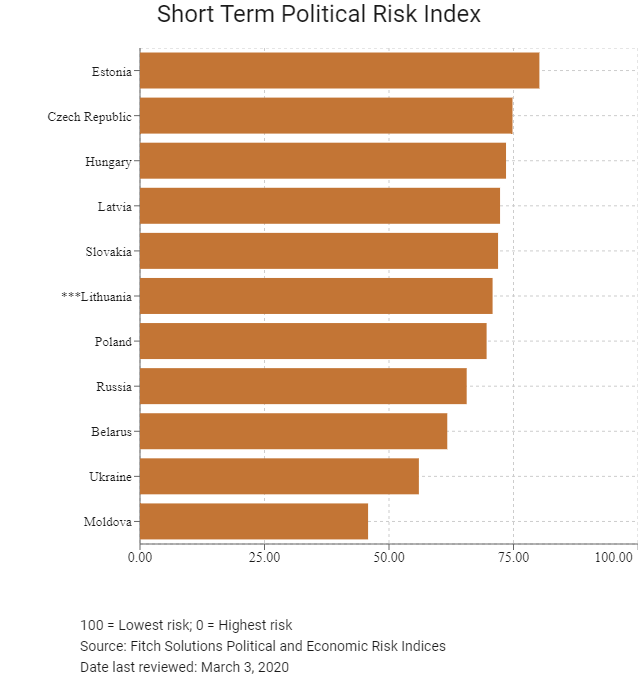
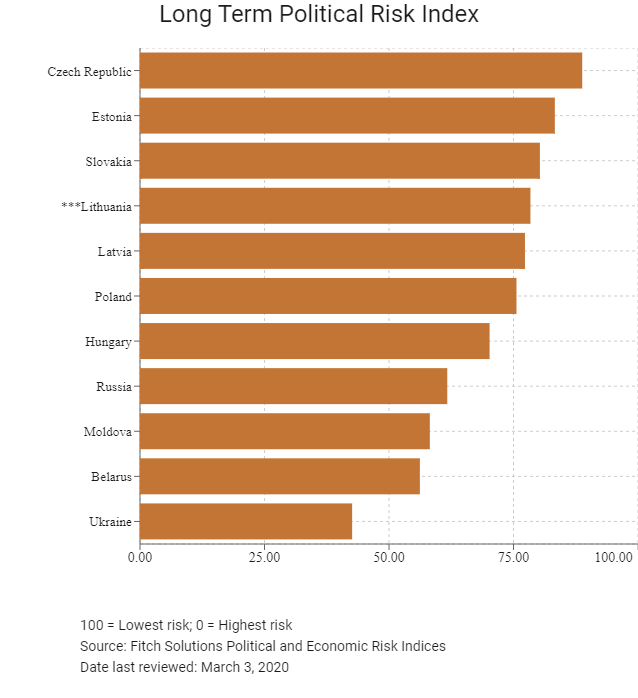
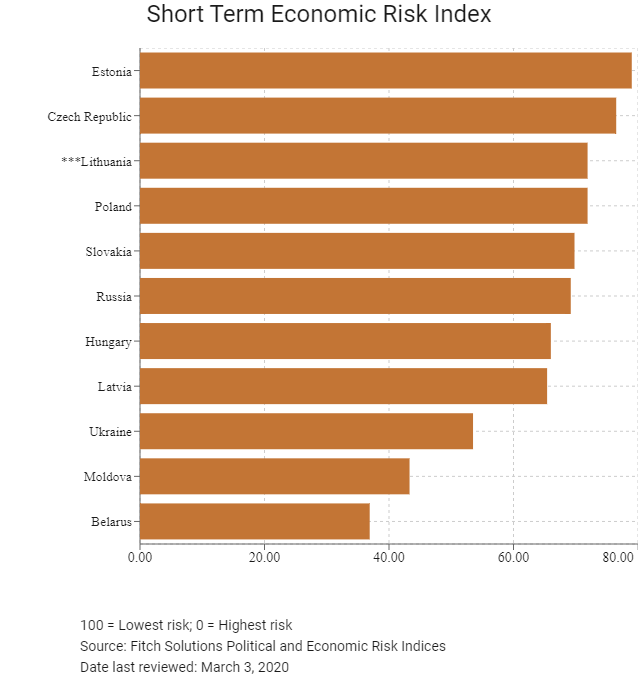
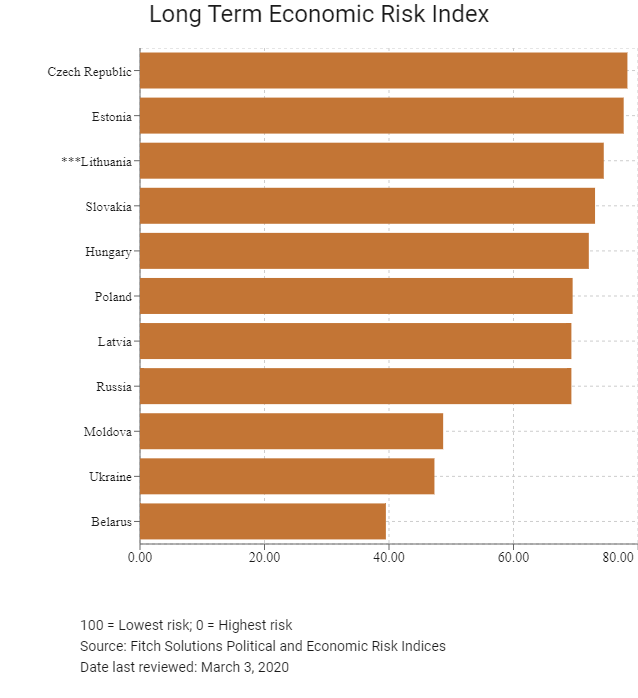
Fitch Solutions Operational Risk Index
|
Operational Risk |
Labour Market Risk |
Trade and Investment Risk |
Logistics Risk |
Crime and Security Risk |
|
|
Lithuania Score |
69.5 |
61.2 |
71.4 |
74.3 |
71.0 |
|
Central and Eastern Europe Average |
62.7 |
58.5 |
63.5 |
67.5 |
61.2 |
|
Central and Eastern Europe Position (out of 11) |
3 |
4 |
2 |
2 |
4 |
|
Emerging Europe Average |
58.0 |
56.3 |
59.1 |
60.5 |
55.9 |
|
Emerging Europe Position (out of 31) |
3 |
7 |
3 |
2 |
5 |
|
Global Average |
49.7 |
50.2 |
49.8 |
49.3 |
49.2 |
|
Global Position (out of 201) |
29 |
35 |
26 |
24 |
31 |
100 = Lowest risk; 0 = Highest risk
Source: Fitch Solutions Operational Risk Index

|
Country |
Operational Risk Index |
Labour Market Risk Index |
Trade and Investment Risk Index |
Logistics Risk Index |
Crime and Security Risk Index |
|
Estonia |
71.2 |
63.1 |
76.3 |
71.0 |
74.3 |
|
Czech Republic |
69.6 |
60.6 |
67.8 |
73.6 |
76.5 |
|
Lithuania |
69.5 |
61.2 |
71.4 |
74.3 |
71.0 |
|
Poland |
69.2 |
59.2 |
69.3 |
75.5 |
72.8 |
|
Latvia |
66.8 |
63.4 |
67.1 |
69.4 |
67.4 |
|
Slovakia |
63.8 |
52.1 |
66.5 |
66.8 |
69.6 |
|
Hungary |
63.5 |
55.7 |
62.0 |
70.1 |
66.3 |
|
Belarus |
59.1 |
60.1 |
58.6 |
66.6 |
51.3 |
|
Russia |
58.3 |
65.9 |
58.6 |
67.9 |
40.6 |
|
Moldova |
49.8 |
44.7 |
51.7 |
53.4 |
49.3 |
|
Ukraine |
48.7 |
57.9 |
49.0 |
54.4 |
33.6 |
|
Regional Averages |
62.7 |
58.5 |
63.5 |
67.5 |
61.2 |
|
Emerging Markets Averages |
46.2 |
48.2 |
46.5 |
45.0 |
44.9 |
|
Global Markets Averages |
49.7 |
50.2 |
49.8 |
49.3 |
49.2 |
100 = Lowest risk; 0 = Highest risk
Source: Fitch Solutions Operational Risk Index
Date last reviewed: March 3, 2020
Hong Kong’s Trade with Lithuania
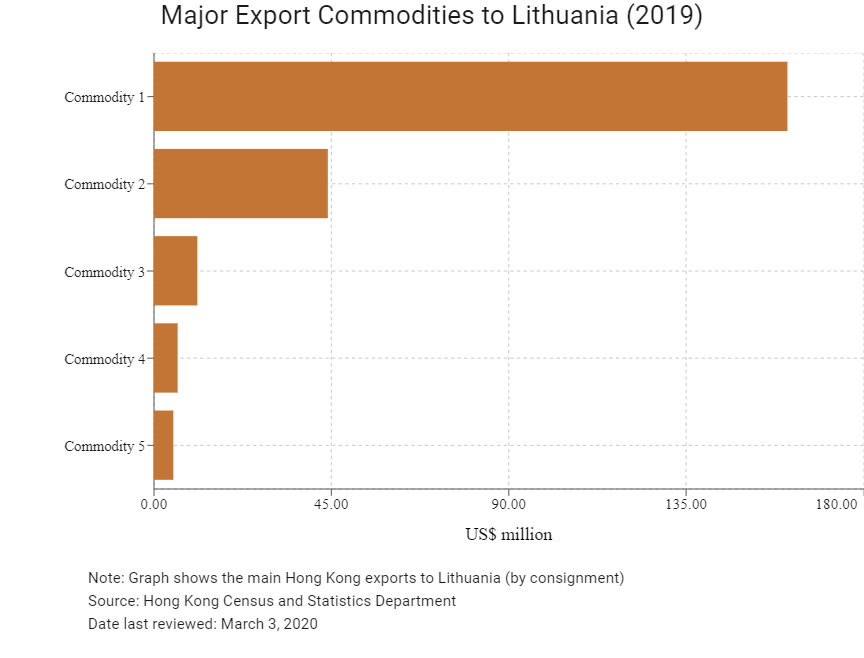
| Export Commodity | Commodity Detail | Value (US$ million) |
| Commodity 1 | Telecommunications and sound recording and reproducing apparatus and equipment | 160.7 |
| Commodity 2 | Electrical machinery, apparatus and appliances, and electrical parts thereof | 44.1 |
| Commodity 3 | Office machines and automatic data processing machines | 11.0 |
| Commodity 4 | Photographic apparatus, equipment and supplies and optical goods; watches and clocks | 6.0 |
| Commodity 5 | Articles of apparel and clothing accessories | 4.9 |
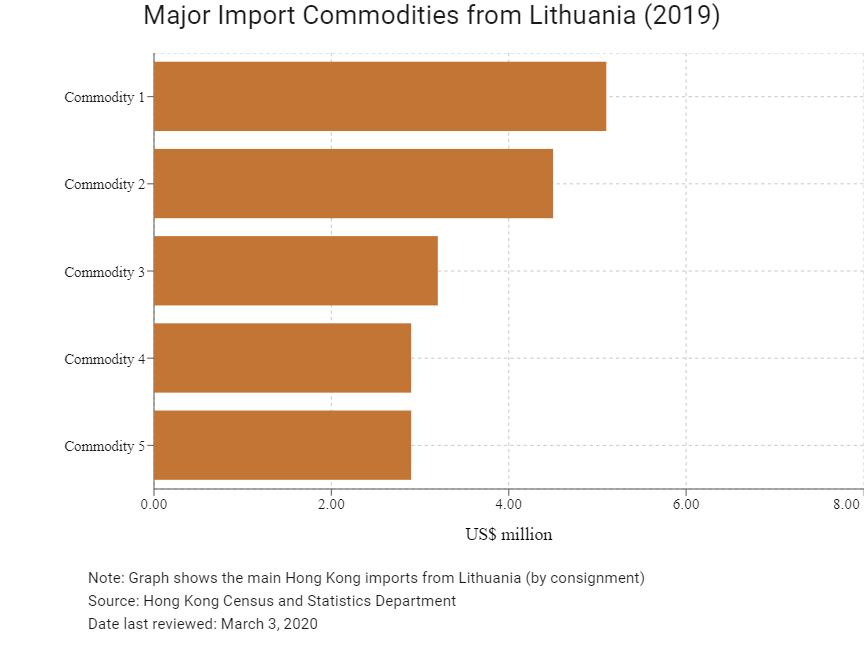
| Import Commodity | Commodity Detail | Value (US$ million) |
| Commodity 1 | Essential oils and resinoids and perfume materials; toilet, polishing and cleansing preparations | 5.1 |
| Commodity 2 | Dairy products and birds' eggs | 4.5 |
| Commodity 3 | Tobacco and tobacco manufactures | 3.2 |
| Commodity 4 | Office machines and automatic data processing machines | 2.9 |
| Commodity 5 | Metalliferous ores and metal scrap | 2.9 |
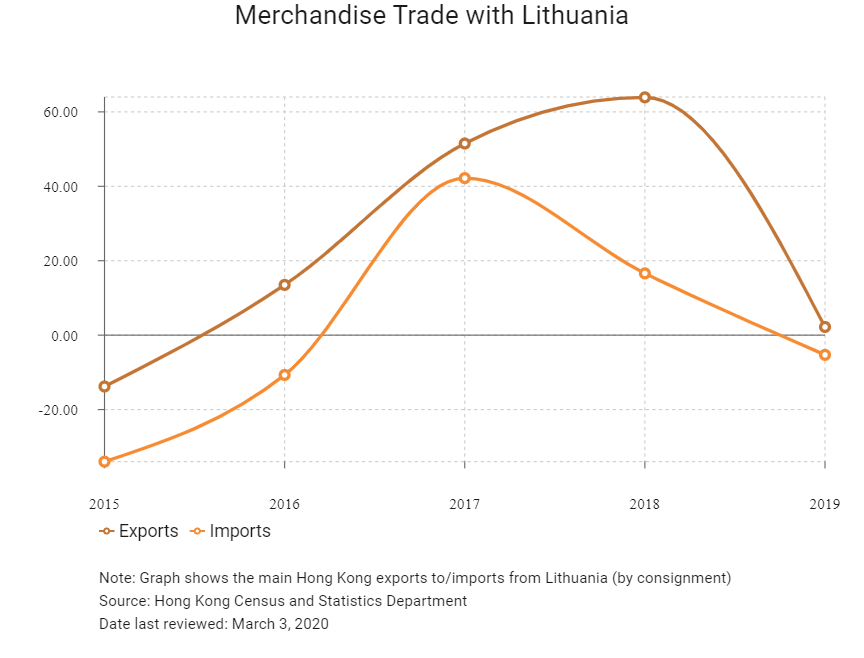
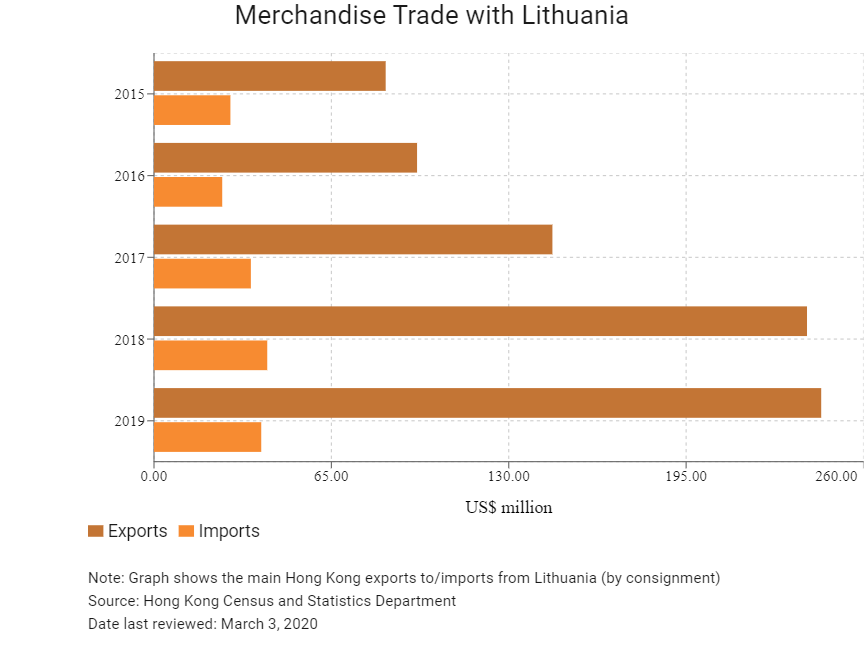
Note: Graph shows Hong Kong exports to/imports from Lithuania (by consignment)
Exchange Rate HK$/US$, average
7.75 (2015)
7.76 (2016)
7.79 (2017)
7.83 (2018)
7.77 (2019)
|
2019 |
Growth rate (%) |
|
|
Number of European residents visiting Hong Kong |
1,747,763 |
-10.9 |
|
Number of emerging Europe citizens residing in Hong Kong |
114 |
29.6 |
|
Number of Lithuanian residents visiting Hong Kong |
4,453 |
2.2 |
Note: Growth rate for resident data is from 2015 to 2019, no UN data available for intermediate years
Source: United Nations Department of Economic and Social Affairs – Population Division
Date last reviewed: March 3, 2020
Commercial Presence in Hong Kong
|
2020 |
Growth rate (%) |
|
|
Number of EU companies in Hong Kong |
N/A |
N/A |
|
- Regional headquarters |
||
|
- Regional offices |
||
|
- Local offices |
Treaties and agreements between Hong Kong and Lithuania
- An agreement between Mainland China and Lithuania for the avoidance of double taxation and the prevention of fiscal evasion with respect to taxes on income and on capital came into force in October 1996.
- Lithuania does not have a BIT with Hong Kong but does have one with Mainland China that entered into force on June 1, 1994. The agreement concerns the encouragement and reciprocal protection of investment and is intended to create favourable conditions for investors from both countries.
Sources: UNCTAD, China State Administration of Taxation
Chamber of Commerce (or Related Organisations) in Hong Kong
Lithuanian Chamber of Commerce in Hong Kong
Address: Suite 1106-08, 11/F, Tai Yau Building, No.181 Johnston Road, Wan Chai, Hong Kong
Email: info@litchamber.hk
Tel: (852) 3179 5320
Fax: (852) 3179 5321
Source: Lithuanian Chamber of Commerce in Hong Kong
Lithuanian Honorary Consul in SAR of Hong Kong and Macao
Address: 2/F, 79 Wyndham Street, Central, Hong Kong
Email: rajsital@netvigator.com
Tel: (852) 2522 2908
Fax: (852) 2810 5771
Source: Hong Kong Protocol Division Government Secretariat
Visa Requirements for Hong Kong Residents
HKSAR passport holders do not need a visa for Lithuania for a period of up to 90 days.
Source: Visa on Demand
Date last reviewed: March 3, 2020
 Lithuania
Lithuania





